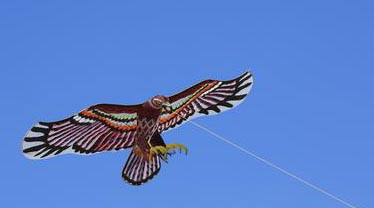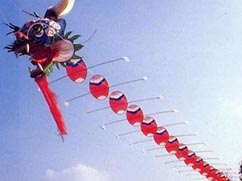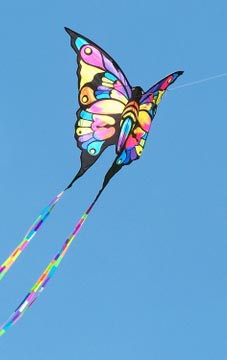|
The kite originated in China.
One Chinese philosopher named Mo Zi (478-392BC) who spent three years
on making a hawk out of wood which was broken after one day’s flight.
Probably that wooden hawk was the first kite in China. According to the
historical records, Lu Ban, one disciple of Mo Zi, made a magpie out of
bamboo, which could fly for three days in good condition. Chinese kite
has been praised as the forerunner of the modern airplane by some people
today.
 The
earliest Chinese kites were made of wood and called Mu Yuan(wooden kites);
they dated as far back as the Warring States Period (475-221 B.C.) at
least two millennia ago. Later the paper kite wasl called Zhi Yuan. During
the Tang Dynasty (618-907AD), people began to fix on kites with bamboo
strips. When flying in the air it would vibrate and ring in the breeze
like a zheng (a stringed instrument). Since then, the popular Chinese
name for the kite has become Feng Zheng (wind zheng). The kites made today
in certain localities are fixed with rings to send out pleasant sound
in the wind.
The
earliest Chinese kites were made of wood and called Mu Yuan(wooden kites);
they dated as far back as the Warring States Period (475-221 B.C.) at
least two millennia ago. Later the paper kite wasl called Zhi Yuan. During
the Tang Dynasty (618-907AD), people began to fix on kites with bamboo
strips. When flying in the air it would vibrate and ring in the breeze
like a zheng (a stringed instrument). Since then, the popular Chinese
name for the kite has become Feng Zheng (wind zheng). The kites made today
in certain localities are fixed with rings to send out pleasant sound
in the wind.
Early kites were used for military purposes. Historical records say they were large in size; some were powerful enough to carry men up in the air to observe enemy’s movements, and others were used to scatter propaganda leaflets over hostile forces or transmit military information. But the main function of kite is for amusement in the spring time. In the mid Tang Dynasty (618-907), the society was stable and peaceful; the function of kites was gradually changed from military purpose to entertainment. With the innovation of papermaking, the raw material of kite changed from silk to paper. Kite became popular among civilians with a richer variety of forms and reached the peak point in the Song Dynasty (960-1279AD). Participated by the literati, the making and the decoration of kites underwent great development. Kite making became a profession due to the large demand.
The Ming (1368-1644) and Qing dynasties (1644-1911AD), was the peak period of the Chinese kite. The kites underwent great development in size, design, decoration and flying skills. Scholars at that time made kite by themselves, and sent to relatives and friends as a gift, regarding it a literary pursuit. In recent years, kite flying has publicized as a sports activity as well as entertainment.
Certain enthusiasts enjoy flying kites during the night. They hang small colored lanterns on the line with candles burning inside, which go up high in the air to decorate the night sky with strings of glimmering lights, adding much to the fun.
Chinese kites fall into four major categories:
Centipede shaped kites
 Centipede shaped kites always have a head and a train of kite disks. Head
and disks are interconnected with one, or three lines. Centipede shaped
kites may have enormous tractive power. These kites give an attractive
and vivid in-flight view, especially when the wind moves and deforms the
kite train. Centipedes with dragon heads are typical for this kind of
kite.
Centipede shaped kites always have a head and a train of kite disks. Head
and disks are interconnected with one, or three lines. Centipede shaped
kites may have enormous tractive power. These kites give an attractive
and vivid in-flight view, especially when the wind moves and deforms the
kite train. Centipedes with dragon heads are typical for this kind of
kite.
Hard-Winged Kites
Kites with hard wings have symmetrically arranged bamboo frames; the rigid central frame enhances the overall rigidity of the kite, the frame was covered by glued paper or silk. Yangjiabu kites are a typical example for Kites with hard wings from WeiFang. The kite sail is made of paper or silk, and is colored by woodcut and/or hand painted. Pictorial motifs and kite forms are of local custom.
Soft-Winged- kites
The wings of this kind of kites do have rigid upper rims. The lower sections of all these wings are flexible. This type of kites often has more than one pair of wings that are arranged one pair above the other. The
kite on the left side is an example with two pairs of wings, representing
a precious breed of a goldfish. Every single Wing has a rigid upper rim
made of bamboo. Pictorial motives and forms represent all kind of birds,
insects, fishes etc. When floating in the wind these kites give a very
vivid sight of flight.
than one pair of wings that are arranged one pair above the other. The
kite on the left side is an example with two pairs of wings, representing
a precious breed of a goldfish. Every single Wing has a rigid upper rim
made of bamboo. Pictorial motives and forms represent all kind of birds,
insects, fishes etc. When floating in the wind these kites give a very
vivid sight of flight.
Flat-Kites
Flat kites are constructed within a single plane, and are made of a complete rigid bamboo frame. All (four) sides of the frame or of the frame segments are limited by bamboo strips.
These kites are very easy to fly. Most of them are flown with long tails to grant a stable in-flight behavior. Flat kites are built in many forms and types, very often with pictorial motifs from ancient myths and religious ideas, very often with a picture of the ying-yang sign.
How to make a kite?
First step is to make the frame. For the frame, the right kind of bamboo must be selected. It should be thick and strong for a kite of large dimensions in order to stand the wind pressure. For miniature kites, on the other hand, thin bamboo strips are to be used.
The second step is to cover the frame. This is normally done with paper, sometimes with silk. Silk kites are more durable and generally of higher artistic value.
The third step is to paint the kite. Auspicious designs and symbols are used to decorate the kite. That can make the kite have good artistic view.
There are a lot of skillful craftsmen in making kite in China.On the 1903 New York International Fair, kites made by Ha Changying, received a warm welcome. At the 1914 Panama International Fair, Wei Yuantai from Tianjin won the gold metal prize for his kites.
In 1983 a large-scale kite-flying competition was held in Tianjin. A "dragon-headed centipede" of a hundred sections, with a total length of a hundred meters, was flown up by 6 young men.
The well-known Weifang (Shandong Province) Kite Festival has become an annual feature in the country, drawing hundreds of participants each April from all over the world. Thus Weifang is called the Kite Capital of the World.
 The
earliest Chinese kites were made of wood and called Mu Yuan(wooden kites);
they dated as far back as the Warring States Period (475-221 B.C.) at
least two millennia ago. Later the paper kite wasl called Zhi Yuan. During
the Tang Dynasty (618-907AD), people began to fix on kites with bamboo
strips. When flying in the air it would vibrate and ring in the breeze
like a zheng (a stringed instrument). Since then, the popular Chinese
name for the kite has become Feng Zheng (wind zheng). The kites made today
in certain localities are fixed with rings to send out pleasant sound
in the wind.
The
earliest Chinese kites were made of wood and called Mu Yuan(wooden kites);
they dated as far back as the Warring States Period (475-221 B.C.) at
least two millennia ago. Later the paper kite wasl called Zhi Yuan. During
the Tang Dynasty (618-907AD), people began to fix on kites with bamboo
strips. When flying in the air it would vibrate and ring in the breeze
like a zheng (a stringed instrument). Since then, the popular Chinese
name for the kite has become Feng Zheng (wind zheng). The kites made today
in certain localities are fixed with rings to send out pleasant sound
in the wind. Early kites were used for military purposes. Historical records say they were large in size; some were powerful enough to carry men up in the air to observe enemy’s movements, and others were used to scatter propaganda leaflets over hostile forces or transmit military information. But the main function of kite is for amusement in the spring time. In the mid Tang Dynasty (618-907), the society was stable and peaceful; the function of kites was gradually changed from military purpose to entertainment. With the innovation of papermaking, the raw material of kite changed from silk to paper. Kite became popular among civilians with a richer variety of forms and reached the peak point in the Song Dynasty (960-1279AD). Participated by the literati, the making and the decoration of kites underwent great development. Kite making became a profession due to the large demand.
The Ming (1368-1644) and Qing dynasties (1644-1911AD), was the peak period of the Chinese kite. The kites underwent great development in size, design, decoration and flying skills. Scholars at that time made kite by themselves, and sent to relatives and friends as a gift, regarding it a literary pursuit. In recent years, kite flying has publicized as a sports activity as well as entertainment.
Certain enthusiasts enjoy flying kites during the night. They hang small colored lanterns on the line with candles burning inside, which go up high in the air to decorate the night sky with strings of glimmering lights, adding much to the fun.
Chinese kites fall into four major categories:
Centipede shaped kites
 Centipede shaped kites always have a head and a train of kite disks. Head
and disks are interconnected with one, or three lines. Centipede shaped
kites may have enormous tractive power. These kites give an attractive
and vivid in-flight view, especially when the wind moves and deforms the
kite train. Centipedes with dragon heads are typical for this kind of
kite.
Centipede shaped kites always have a head and a train of kite disks. Head
and disks are interconnected with one, or three lines. Centipede shaped
kites may have enormous tractive power. These kites give an attractive
and vivid in-flight view, especially when the wind moves and deforms the
kite train. Centipedes with dragon heads are typical for this kind of
kite. Hard-Winged Kites
Kites with hard wings have symmetrically arranged bamboo frames; the rigid central frame enhances the overall rigidity of the kite, the frame was covered by glued paper or silk. Yangjiabu kites are a typical example for Kites with hard wings from WeiFang. The kite sail is made of paper or silk, and is colored by woodcut and/or hand painted. Pictorial motifs and kite forms are of local custom.
Soft-Winged- kites
The wings of this kind of kites do have rigid upper rims. The lower sections of all these wings are flexible. This type of kites often has more
 than one pair of wings that are arranged one pair above the other. The
kite on the left side is an example with two pairs of wings, representing
a precious breed of a goldfish. Every single Wing has a rigid upper rim
made of bamboo. Pictorial motives and forms represent all kind of birds,
insects, fishes etc. When floating in the wind these kites give a very
vivid sight of flight.
than one pair of wings that are arranged one pair above the other. The
kite on the left side is an example with two pairs of wings, representing
a precious breed of a goldfish. Every single Wing has a rigid upper rim
made of bamboo. Pictorial motives and forms represent all kind of birds,
insects, fishes etc. When floating in the wind these kites give a very
vivid sight of flight. Flat-Kites
Flat kites are constructed within a single plane, and are made of a complete rigid bamboo frame. All (four) sides of the frame or of the frame segments are limited by bamboo strips.
These kites are very easy to fly. Most of them are flown with long tails to grant a stable in-flight behavior. Flat kites are built in many forms and types, very often with pictorial motifs from ancient myths and religious ideas, very often with a picture of the ying-yang sign.
How to make a kite?
First step is to make the frame. For the frame, the right kind of bamboo must be selected. It should be thick and strong for a kite of large dimensions in order to stand the wind pressure. For miniature kites, on the other hand, thin bamboo strips are to be used.
The second step is to cover the frame. This is normally done with paper, sometimes with silk. Silk kites are more durable and generally of higher artistic value.
The third step is to paint the kite. Auspicious designs and symbols are used to decorate the kite. That can make the kite have good artistic view.
There are a lot of skillful craftsmen in making kite in China.On the 1903 New York International Fair, kites made by Ha Changying, received a warm welcome. At the 1914 Panama International Fair, Wei Yuantai from Tianjin won the gold metal prize for his kites.
In 1983 a large-scale kite-flying competition was held in Tianjin. A "dragon-headed centipede" of a hundred sections, with a total length of a hundred meters, was flown up by 6 young men.
The well-known Weifang (Shandong Province) Kite Festival has become an annual feature in the country, drawing hundreds of participants each April from all over the world. Thus Weifang is called the Kite Capital of the World.
Mobile:(+86-1350 110 3837) Wechat:(13501103837) E-mail: chinasilkrug@msn.com